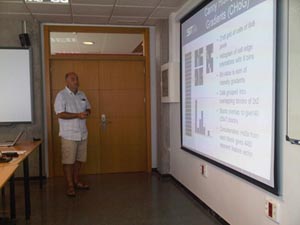|
|
Titulo: Person Tracking and Event Recognition over A Sensor Network Impartido por: Paul Miller |
Presentación en PDF  |
Paul MillerDr Paul Miller is a Senior Lecturer in the School of Electronics, Electrical Engineering and Computer Science at Queen’s University Belfast (QUB). He is also a Research Director of the Intelligent Surveillance Systems group in the newly formed £30M funded Centre for Secure Information Technology. Previously, he worked as a senior research scientist at the Defence, Science and Technology Organisation, Australia where he led a team providing science and technology advice on unmanned aerial surveillance systems. Before that he worked as a research fellow at QUB. He received his Ph.D. in Optical Image Processing from QUB in 1989. Since returning to academia he has continued to work in video analytics for both defence and civilian CCTV applications, and also biomedical image analysis. He has published over 60 papers in image and video analysis, including a best paper award for his work on object recognition. During his academic career he has constantly worked in close collaboration with industry, including both multinational and SME companies. |
|
Resumen:
Laboratory and bus video demonstrations of the gender profiling are presented for the first time. The final part of the talk shows how the atomic events generated by the trajectories and profiles can then be combined using a rule-based approach to give higher-level compound events which have meaning from a security view-point. Implementation of these rules using surveillance agents in a multi-agent surveillance architecture is then described. Recognition rates of approx 80-90% for both normal and anti-social events is obtained. A comparison is also performed which shows that the communication overhead for an agent based approach is significantly less than that for a centralised approach. |
|
Seminarios

- Está aquí:
-
Inicio

-
Actividades formativas

-
Seminarios

- Person Tracking and Event Recognition over A Sensor Network
Próximos Eventos
| Sin eventos |
 We present a multi-agent surveillance architecture for event recognition and tracking. An overview is firstly given of the application scenario, “Secure Corridors of Transport”, and the concept of active CCTV is introduced. The main focus of the presentation is the tracking of a person in a localised space using a sensor network. This is described and results and demos are presented showing a system accuracy of approx 0.1m. Video gender profiling of passengers using face and full-body features is then described and once again results presented showing a classification error of 10-20%.
We present a multi-agent surveillance architecture for event recognition and tracking. An overview is firstly given of the application scenario, “Secure Corridors of Transport”, and the concept of active CCTV is introduced. The main focus of the presentation is the tracking of a person in a localised space using a sensor network. This is described and results and demos are presented showing a system accuracy of approx 0.1m. Video gender profiling of passengers using face and full-body features is then described and once again results presented showing a classification error of 10-20%.